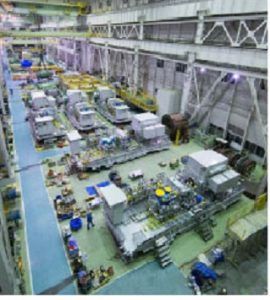What goes into a 700 bar compressor
Pre-Salt development projects continue to expand offshore Brazil into ever deeper waters year after year. Consequently, the required discharge pressures for re-injection compressors aboard FPSOs are likely to exceed 550 bar levels, and requirements are there for design of higher pressure compressors.
For application in these conditions, Mitsubishi Heavy Industries has developed a super high pressure compressor. This super high pressure compressor can be used as re-injection compressor or injection compressor such as in the CCS plant and FPSO.

This article contains excerpts from the paper, "Development of High-Pressure Ratio and Wide-Operating Range 700bar Compressor", presented by Shinichiro Tokuyama Hiroshima, Akihiro Nakaniwa and Satoshi Saburi of Mitsubishi Heavy Industries and Diogo Yoshikazu Ujihara of Petrobras at the 2016 Asia Turbomachinery and Pump Symposium.
Rotor stability is the most considerable requirement for super high pressure operation because of the high density flow destabilizing force in the compressor. From the point of view of rotor dynamics, the short bearing span and high shaft diameter are desirable for the stability of the rotor. On the other hand, from the point of view of aerodynamics performance, that rotor arrangement may decrease the performance.
A parametric study was conducted to optimize the boss ratio of compressor stage to get both high rotor dynamic stability and high aerodynamic performance. Rotating stall can be the cause of sub-synchronous vibrations in super high pressure operating condition and it induces narrow
operation range. To prevent such a situation, a vaned diffuser was applied for developed compressor stage and it can also help to reduce the diffuser radius space.Seal leakage flow has large effects on rotor stability and aerodynamic performance. For this item, the hybrid construction of hole pattern seal and step labyrinth seal was proposed. Hole pattern seal is well known as damping seal for high pressure compressor. CFD dynamic analysis and dynamic characteristics test for this hybrid hole pattern seal are introduced under the condition of high density by using hydraulic shaker device. The extensive verification test of developed super high pressure compressor were conducted with impeller of optimized boss ratio, vaned diffuser and hybrid honeycomb seal, and has demonstrated the robustness for all field conditionsincluding molecular weight variation with high aerodynamic performance and small vibration.
The prerequisite criteria in the design of these higher pressure compressors for hostile marine conditions are invariably:
1. Reliability
2. Operability
3. Compact Design.
In order to realize above requirement, Mitsubishi has developed a High Pressure Ratio 700 bar Compressor with a wide range operational capability and incorporating the following features: 1. High stability and high reliability for volatile well conditions (Log decrement : more than 2.5). 2. Wide operating range for volatile well conditions (2 times wider than conventional types) 3. High efficiency resulting in real energy savings (Polytropic Efficiency : app. 70% ) 4. Compact design & reduced weight optimized for fixed and floating offshore facilities (50% less than conventional type)
The OEM’s 1st generation design commenced with the manufacturing and delivery of a synthesis gas compressor for an ammonia plant in 1986. The 2nd generation was marked by the production and delivery of a CO2 compressor for a Urea plant in 1994. This CO2 compressor was equipped with a number of advanced design feature including 3-D high efficiency impellers, overhung dampers, swirl cancellers, etc. The 3rd generation kicked off in 2000, with a phased program to develop a compressor ultimately targeted to achieve a discharge pressure rating of 700 bar.
Shortly thereafter, in 2003, phase 1 verification shop testing was carried out on a casing at 450 bar. At that point in time, the highest needs in the global injection market were expected to be in the range of 450 bar. For this 3rd generation compressor, relatively new technology, such as high accuracy CFD, anti-rotating stall, firm nozzle design, and impeller brazing were applied. In 2010, the 4th generation program was launched to develop the “super high pressure compressor” with a target pressure rating of 1000 bar. This 4th generation compressor is enhanced with proven high pressure compressor design features, such as, high boss ratio impellers, high damping seals and wide flow stages.
The design concept of developed super high pressure compressor can be applied up to a pressure rating of 1000 bar. The super high pressure compressor was designed for 550 bar reinjection service which is currently the range with the highest demand globally, particularly offshore Brazil.
The impeller was divided into high and low pressure sections, and arranged as back-to-back. Thus, losses due to internal circulation flow could be reduced, and variations in shaft thrust force due to variations in operating conditions could also be reduced. The design of the super high pressure compressor features enhancements from the 3rd generation reinjection compressor and takes into consideration A) high gas density means high destabilizing force, B) low actual volume flow is narrow flow path, c) high pressure means high stress, D) variation of gas well means wide operating range.
For item (A), high boss ratio impeller and hole pattern seals were applied. The dynamic characteristics of hole pattern seals were evaluated by CFD analysis and component testing. For the item B), wide flow path impellers, high boss ratio impellers and vaned diffusers were applied. In order to verify Compressor model 3V-6B Gas handled CO2+CH4 Mol Weight 18~44 Discharge Pressure 550 - 700 bar Pressure Ratio 4.3 Design Speed (MCR) 13,000 rpm Required Power 10,000 kW. Impeller stage performance, single stage performance testing was conducted in keeping with manufacturer’s own standard manufacturing practice. For the item C), the compact design concept was applied and the strength of each part was evaluated by FEM analysis. For item D), the double balance piston was applied to reduce a variation in the total thrust force acting on the shaft due to variation in gas well conditions. In addition to that, vaned diffuser can also help to avoid rotating stall.